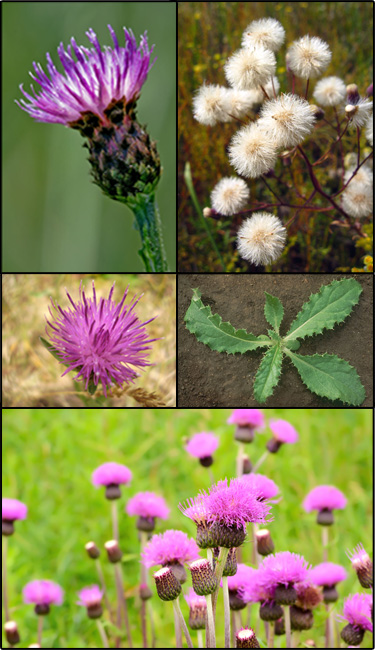Canada thistle (Cirsium arvense)
 Common Names: Creeping thistle, Field thistle, Californian thistle
Common Names: Creeping thistle, Field thistle, Californian thistleDescription: This species is listed under Regulation No. 715 - Seed Law Implementation as a prohibited noxious weed by the Michigan Department of Agriculture. Canada thistle was introduced to North America from Europe in the early 1600s.
Habit: Perennial, rhizomatous thistle ranging in height from 0.6-1.5 m (2-5 ft), forms large monocultures.
Leaves: Simple, alternate, lance-shaped, crinkly, tapering, irregular lobes and spiny toothed margins.
Stems: Upright; slender and branching towards the top; becoming increasingly hairy with age.
Flowers: Numerous, purple-lavender in color, small flower heads, less than 2.5 cm (1 in) high, clustered at the tops of stems, fragrant; bloom June through September.
Fruit and seeds: Seeds are small, light brown; tufts of hair attached to the tip for wind dispersal; one plant produces between 1500-5000 seeds, which can germinate 8-10 days after flowering begins and persist in the seed bank for up to 20 years.
Habitat: Found in disturbed open areas, roadsides, agricultural fields; invades prairie and riparian areas; salt-tolerant; shade intolerant.
Reproduction: Primarily by creeping, laterally spreading rhizomes, but also by prolific seed production; dioecious, with separate male and female clones; some hermaphroditic forms.
Similar species: Native swamp thistle (Cirsium muticum) has sticky flower heads; non-native weeds bull thistle (Cirsium vulgare), European swamp thistle (C. palustre), and musk thistle (Carduus nutans) have spiny winged stems.
Monitoring and rapid response: Monitor sunny, disturbed sites including degraded grasslands, open woodlands, edge habitats and restoration sites. Begin control efforts in highest quality areas; pull seedlings within 2.5 weeks after germination or they become perennial; Canada thistle is clonal; resprouts from root fragments. Herbicides are most effective with two applications per season: in spring, just before flowering, and in fall on new growth after mowing, treat all stems. Different strains of Canada thistle respond differently to the same herbicide; may require 5-10 years of ongoing efforts. This species is extremely difficult to eradicate - research control options thoroughly. Credits: The Michigan Natural Features Inventory (MNFI) has partnered with MISIN to provide the information in this fact sheet. Species images and/or information were used with permission from "A Field Identification Guide to Invasive Plants in Michigan's Natural Communities" and "A Field Guide to Invasive Plants of Aquatic and Wetland Habitats for Michigan.
Common Name: | Canada thistle |
Scientific Name: | Cirsium arvense |
Family: | Asteraceae (Aster) |
Duration: | Perennial |
Habit: | Herbs |
USDA Symbol: | CIAR4 |
 View Species Course |
|
